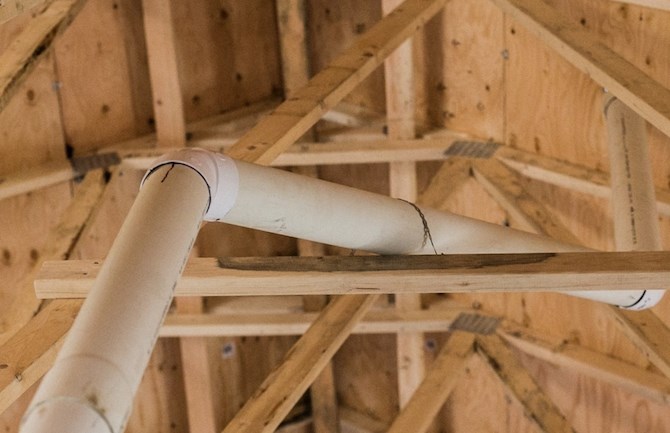
Image Credit: Submitted/Canadian Association of Radon Scientists and Technologists
July 11, 2021 - 9:00 AM
Over the past winter, more than 1,000 homes in the Central Okanagan took up an offer to get free test kits to see if their homes were safe from radon.
The results show that 52 per cent of the 214 homes tested in Lake Country and 51 per cent of the 39 tested in Peachland were above the Canadian standard of 200 becquerels per cubic metre (Bq/m3).
Levels were lower in West Kelowna (32 per cent of 207 tests) and Kelowna (22 per cent of 573 tests). The overall rate for the region of 32 per cent was far above the Canadian average of eight per cent of homes.
That means, many Central Okanagan residents may be slowly contracting deadly lung cancer.
“One of my clients passed away a few weeks ago from lung cancer,” Cody Wright, owner of Synergy Home Inspections, told iNFOnews.ca. “They found it pretty late. We mitigated their house but, at the time we were mitigating, they were already in treatment.”
Wright was the first contractor in the South Okanagan to be certified to do this kind of work and stressed that this is not simply a Central Okanagan problem. He’s dealt with it throughout the Okanagan and into the Kootenays.
It’s just that the free testing program was launched in the Central Okanagan last fall so that data is available. Little data has been collected over the years across the country with only 5,500 such kits distributed.
READ MORE: Okanagan has hotter spots for deadly radon gas than Kamloops
A B.C. Lung Association report that went to the Regional District of Central Okanagan earlier this week showed hot spots throughout most of B.C.
“The Capital Regional District (Victoria) and metro Vancouver are consistently low in radon – so the province is not seeing the issue as a priority,” it says.
Lung cancer caused by smoking kills about 20,000 people in Canada each year. Radon comes second at 3,000.
Radon is an odorless, colourless gas that originates with uranium deposits. It seeps into homes and is most deadly in the winter when windows are closed so it doesn’t dissipate.
“There’s a ton of radon throughout the whole Kelowna area and West Kelowna because there’s so much bedrock and there’s a lot of uranium deposits,” Wright said.
Building code changes that came into effect in 2015 require radon mitigation in new homes. Those are generally plastic pipes venting the gas out above the roof but that’s no guarantee of safety.
A chart in the report that went to the regional district shows that about 100 homes built since 2015 were tested that past winter. About one-quarter tested above the safe level.
“One street may have high levels in one home and right next to them they may have low levels,” Pam Warkentin, executive director of the Canadian Association of Radon Scientists and Technologists,” told iNFOnews.ca. “When you look at the data there were high levels in all ages of homes.”
In Lake Country, five per cent of the homes tested were five times the safe level.
Wright’s own home in Summerland had levels of 1,500 Bq/m3 and his neighbour had readings over 3,000 Bq/m3. After doing mitigation, those fell below 50.
Mitigation is not simple and is not cheap, although there may be uncertified contractors who will do the work for $2,000.
It requires testing for air flow and pressures and such things as drilling into the concrete basement and installing pipes to vent the gas. Newer homes may just need fans installed into the existing system but those aren't always adequate to do the job.
The work, done properly, is likely to cost more in the $3,500 to $6,000 range, Wright said. It's more expensive in B.C. than other parts of the country.
But the health benefits are worth it.
“I’ve had multiple clients that have had lung-related issues, specifically cancer and, obviously, they are trying to catch this and nip it in the bud before it;s too late,” Wright said.
Last fall’s test kit program was funded through the B.C. Lung Association. The regional district agreed to continue to support the program but only 200 kits will be available this year.
Thirty-one schools were also tested in the Central Okanagan but results are not available yet.
Concerned residents – especially those who have lung cancer symptoms – can buy their own radon testing kits at online through the B.C. Lung Association or Radon Environmental here.
READ MORE: Before you seal your home this winter, maybe test for radon gas
“Lung cancer has the number one rate of death of all the cancers,” Warkentin said. “One of the challenges is, it’s the least survivable right now because it’s difficult to diagnose. It mimics symptoms of cold and flu, which is why we spend so much time in talking about prevention.”
The best time to test is in the fall or winter and for a minimum of three months.
For more information go to the B.C. Lung Association website here or the Canadian Association of Radon Scientists and Technologists website here.
For a list of certified contractors to mitigate radon leaks, go here.
To contact a reporter for this story, email Rob Munro or call 250-808-0143 or email the editor. You can also submit photos, videos or news tips to the newsroom and be entered to win a monthly prize draw.
We welcome your comments and opinions on our stories but play nice. We won't censor or delete comments unless they contain off-topic statements or links, unnecessary vulgarity, false facts, spam or obviously fake profiles. If you have any concerns about what you see in comments, email the editor in the link above.
News from © iNFOnews, 2021